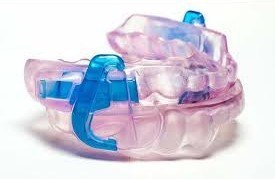What is sleep apnea?
Sleep apnea is a serious breathing disorder where a person stops breathing for 10 seconds or more during sleep. They may have hundreds of these ‘breathless’ episodes throughout the night, repeatedly collapsing the upper airway, disrupting their sleep and starving the body of vital oxygen.
The severity of sleep apnea is categorised by the number of ‘breathless’ episodes per hour as an indexed number:
- mild (5-15);
- moderate (16-30); and
- severe (30+).
The 3 types of sleep apnea
There are three types of sleep apnea:
- Obstructive Sleep Apnea – This is the most common form. It’s the result of the obstruction of the windpipe leading from the nose or mouth to the lungs. The obstruction is usually the result of a narrowed airway, which becomes blocked by the tongue falling backwards or altered development of the skull bones. Obstructive Sleep Apnea (OSA) is more prevalent with age and snoring also increases – which is the result of a narrowed or floppy upper airway.
- Central Sleep Apnea – This is uncommon and results when the signals from the brain that regulate breathing are disrupted in some way.
- Mixed Sleep Apnea – A combination of obstructive and central sleep apnea.
How is sleep apnea different from snoring?
In sleep apnea, there’s total obstruction of the airway, whereas in snoring, there’s partial obstruction of the airway.
Who gets sleep apnea?
Sleep apnea is more common than asthma and is almost as common as diabetes. Four percent of men and 2% of women have the signs and symptoms of sleep apnea (6% overall). It can happen at any age.
- Children: The incidence in children is as high as 4%. Usually, it’s the result of enlarged tonsils, adenoids or of some craniofacial abnormality. Snoring can be the first sign to trigger further investigation.
- Adults: Apnea becomes more common in middle age. It’s more common in men than women, although after menopause, women may be at equal risk as they can lose some muscle tone around their airway.
- Overweight people: Being overweight can be a factor, particularly if you have excess fatty tissue around the neck. In people who aren’t overweight, it’s likely they’ve were born with a narrowed airway.
- Dental patients: Some people who’ve had several teeth extracted, such as for orthodontic treatment, can end up with a smaller arch for their mouth and a tendency towards a constricted airway.
Is sleep apnea really that serious?
Yes, there’s strong evidence that people with sleep apnea die prematurely from a heart attack, stroke, or car or work-related accidents.
Medical impact: Numerous studies show a relationship between patients with OSA and cardiovascular disease, with 57% of OSA patients suffering hypertension. That’s a strong connection!
Accidents: Patients with sleep apnea are more likely to fall asleep at inappropriate times and have a higher rate of car crashes and work-related accidents by a factor of four! That’s 4 times as likely to crash!
Social: Snoring and sleep apnea can be extremely irritating and cause relationship disharmony and family stress. It can be made worse by unexplained sleepiness, mood swings and lack of interest in family life.
How do you know if you have sleep apnea?
How do you treat sleep apnea?
Treatment is needed when you suffer more than five ‘breathless’ episodes per hour of sleep in the presence of symptoms, and higher than 30 regardless of symptoms. While lifestyle changes and surgery are options, the most successful treatment is often the use of a CPAP machine or a dental appliance. Careful diagnosis of the cause of the airway issue is key to success. Talk to us about your circumstances. We are specially trained to help you.

Continuous Positive Airway Pressure (CPAP)
This is a machine that inflates the throat by blowing air into the nose through a mask, preventing collapse of the airway during sleep. Treatment is immediately effective but, unfortunately, US studies reveal that only three people out of 10 continue with it after a six-month period, as many find it inconvenient and the noise annoying.

Dental appliances
These are worn over the teeth like a mouthguard and work by realigning the lower jaw during sleep. They’re effective for mild to moderate cases. Patients are more likely to continue using them compared to CPAP. These specialised dental appliances should be fitted and monitored by a dentist.
Sleep apnea: lifestyle changes vs CPAP vs dental solution vs surgery
| Lifestyle changes | CPAP machine | Dental appliance | Surgery |
| Lose weight | Uncomfortable | Comfortable | Painful |
| Avoid alcohol, caffeine or eating late | Unattractive and noisy | Travels easily | Non-reversible |
| Stop smoking | Irritates, eg, rashes | Non-invasive | Unpredictable result |
| Eliminate sedatives | Causes dry throat | Reversible | Recovery time |
| Sleep on your side and maintain regular sleeping patterns | Inconvenient and cumbersome for travel | Lifetime warranty | Side-effects may be permanent |
| Requires a lifetime commitment | < 50% of CPAP are worn on a nightly basis | 10 of 11 patients chose Silencer over CPAP | Success may range from 30% to 50% |
Sleep apnea or apnoea and the constant waking involved in it can take a serious toll on your health. Call Island Dental in Adelaide on (08) 8449 9777 to talk about sleep apnea or book an appointment online so that we can assess your situation.


